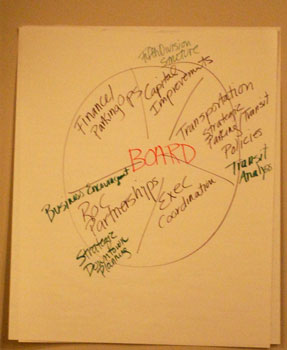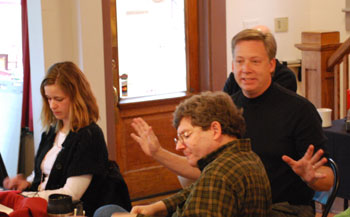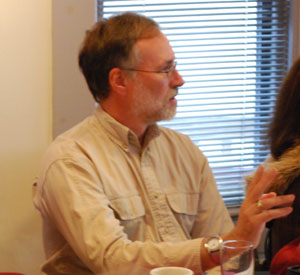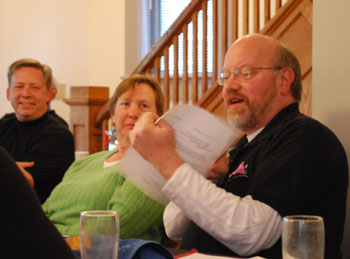Trick or Retreat: DDA Board Plans Year

Final pie chart of proposed DDA board committee structure for 2009. Re-drawn on wall poster by facilitator Fran Alexander from original sketch by Keith Orr.
Ann Arbor’s Downtown Development Authority board held its annual retreat on Tuesday morning, which began with a scrumptious hot breakfast and ended with a giant pie. What the pie offered in size, it lacked in taste: it came in the form of a chart. More on the chart later. Fran Alexander, of Alexander & Associates, acted as the facilitator for the four-hour meeting, which began on time at 8 a.m., and was uninterrupted except for a strictly enforced 10-minute break. It covered three main agenda items: (i) celebrate achievements of 2007-08 (ii) identify priorities for 2009 (iii) establish committee structure for DDA board work.
Alexander had surveyed board members in advance of the meeting to get a sense of their thinking on various topics. Their thinking with respect to the celebration of achievements was: they didn’t want to spend too much time patting themselves on the back. It’s worth noting, though, that throughout the meeting, board members were able to take advantage of a session in the back of the room provided by Lee Ann of RelaxStation on her portable massage chair – back patting included. So after ticking through the underground parking garage along Fifth Avenue and the Fifth and Division reconfiguration (projects now moving forward), the demolition of the old YMCA building at Fifth and William and the installation of green recycling containers downtown (projects already completed) Alexander was ready move to the meat of the meeting: priorities for next year.

Front to back and counterclockwise: Fran Alexander, Rene Greff, John Mouat, Joan Lowenstein, John Splitt, Leah Gunn, John Hieftje, Roger Hewitt, Keith Orr, Sandi Smith, Gary Boren, Russ Collins, Jennifer Hall, Susan Pollay. Standing at right is Ray Detter, who is president of the Downtown Citizens Advisory Council.
Susan Pollay, the DDA’s executive director, provided board members with a two-sided sheet densely packed with accomplishments to compensate for the short shrift that would be alloted to that topic during the meeting. She verbally highlighted the increased funding for the go!pass program, the Link, plus the $750,000 allocation for WALLY (a commuter rail project from Howell to Ann Arbor, which had just received a nudge forward from the AATA the evening before at a special meeting of its board: the AATA voted to become the transportation authority for WALLY). From the sheet Pollay also highlighted three grants to Avalon Housing for four different properties as reflective of the DDA’s commitment to encouraging downtown affordable housing.
In terms of priorities for next year, board chair Jennifer Hall made an early pitch to think about less grand projects and to focus on small projects that could improve the vitality of downtown. Noting that construction of some of the major infrastructure projects – like Fifth and Division and the underground parking garage – would take away from the vitality of downtown, she said that she was hoping the DDA could focus on projects to compensate for some of that lost vitality. Those projects, she said, should be low cost, low effort, but would have a high value.
Later in the meeting, Hall would articulate the idea that the DDA need not itself take on these smaller initiatives, but rather could identify a particular problem to be solved, solicit proposals, and fund whatever entity could solve that problem. To illustrate how this might work, she drew on her experience as a parent, saying that many parents bring their children to the Hands On Museum, enjoy their time there, but then do not stay and do anything else downtown. The problem, she said, is that these parents don’t know where there’s a kid-friendly place to go eat, or where there’s a nice quiet place to spend time with their kids downtown. Solutions to that problem, she said, could be the kind thing DDA could fund – but not necessarily do itself.

Jennifer Hall, Gary Boren, Russ Collins. Collins did not catch a fish that big. He was emphasizing the point that the DDA is not a transportation authority.
Leah Gunn stressed that she would want to see measurable results from the funding of that kind of project.
In the course of the meeting, there seemed to be at least some support for one fun short-term, low-cost option: a skateboard half-pipe in the downtown. Alexander alluded to planning commissioner Craig Borum’s assessment of the proposed 36 parking spaces on the surface of the proposed underground garage as displaying a remarkable lack of creativity. So the idea of a half-pipe installation was floated – perhaps lightheartedly.
What was not lighthearted was Ann Arbor Mayor John Hieftje’s pitch for another short-term, low-cost project: an educational program targeted at downtown landlords to make them aware of the economic climate in Ann Arbor’s downtown. The point of such an education program would be to advocate on behalf of merchants for reasonable rents. His call for immediate action was based on comments Hieftje said Newcombe Clark, president of the Main Street Area Association, had made at the previous day’s downtown marketing taskforce meeting.
At that meeting, Hieftje said, Clark had reported that Ann Arbor would be losing a number of downtown businesses next year. Reached Tuesday by the Chronicle, Clark said he has deep concerns about the health of some of the downtown retailers. He said he’s been hearing a lot of worries from retailers as they head into this critical holiday season.
One data point that would help make the case for what the downtown business climate is really like, said Pollay, would be to do pedestrian counts. Pollay said that the perception that the downtown sidewalks are teeming with pedestrians is based largely on anecdotal observations made on Friday evenings or on football Saturdays.
Pedestrians, as well as the other modes of travel, were a topic discussed throughout the meeting. Roger Hewitt suggested that thinking about a future with different kinds of transit (street cars or rapid bus transit) should also include thinking about differentiated streets. Some streets are more suitable for transit, some are not. Hewitt cited the case of a pedestrian zone in Calgary that in his assessment was not successful, and said that the group needed to think about what factors made some streets suitable as pedestrian zones and others not.
Keith Orr, whose nomination to the DDA board as Dave DeVarti’s replacement is pending confirmation, echoed Hewitt’s sentiments on streets. He said that he’d always been fascinated by the idea of a pedestrian mall, but that if we take away a street, we have to ask if we are taking away someone’s need.
Jennifer Hall was curious to know if there had been any study of the specific barriers that exist to residents using transportation other than cars. Nancy Shore, who coordinates Ann Arbor’s getDowntown program, attended the DDA board retreat, and was able to clarify that the getDowntown program included all employees in the downtown in its surveys, not just those who did not drive.

John Mouat suggested an inventory of empty parcels with a vision of how those parcels could contribute to the fabric of the new downtown.
John Mouat reported that he’d attended the recent TechKnow forum, which assembled various representatives and analysts of the auto industry to focus on discussion of plug-in electric cars. Based on that forum, Mouat suggested that even if it was far from clear that plug-in electrics represented the shape of future personal motorized transportation, it would be worth factoring that possibility into our thinking.
Pollay reported that in connection with plug-in electrics, the DDA had received a letter from the Michigan Student Assembly, asking the DDA to provide incentives for plug-in electric usage. The nature of the incentives, said Pollay, could range from discounted parking rates, to free electricity, to a more optimally located parking spot.
In discussing The Link (free downtown circulator buses), Sandi Smith stressed the same sort of thinking that Hall had previously encouraged with respect to identifying a need and funding a capable entity that can address that need. Said Smith, this was not something the DDA should think of as a funding request from the AATA, but rather as a request from the DDA to the AATA to provide a service (circulator buses) and the DDA’s willingness to fund it. Lowenstein said it was important to be able to answer the question of what we’re accomplishing by running the purple buses (The Link).
Orr said that he liked riding The Link, but that while he could take it to the Michigan Theater, The Link did not make the return trip. Russ Collins, who is director of the Michigan Theater, said, “Call me, Keith, I’ll take you!” Collins invited his fellow board members to reflect on the fact that the DDA is not a transit authority. “We have an Ann Arbor Transit Authority,” he said. So while the DDA had significant resources, those resources were insignificant in the context of the costs of providing transit infrastructure.
The kind of infrastructure Collins wanted the board to focus on was pipes under the streets. At the beginning of the meeting Alexander had noted the expansion of infrastructure as an area where the board itself felt like it had not accomplished very much in the previous year. On the pipes question, Collins suggested that the DDA staff needed to be empowered “to kick our asses, because we’re not going to kick our own asses.” Rene Greff said that ensuring that upgrades happened whenever there were projects that opened up the streets should be “a part of our job.”
After the discussion on priorities for the coming year, Alexander had initially omitted infrastructure from her summary. “Where’s the infrastructure?” asked Collins? As she added the item to the big sheet of poster paper, Collins added, “Put three dollar signs next to that!” The significance of the dollar signs was somewhat ambiguous. Asked by Gunn, “In your mind, do we need to spend money on it?” Collins replied, “It’s not in my mind, it’s a staff priority.”
The discussion of committee structure for the coming year was guided in part by a concern to keep the meetings of the entire board efficient, without leaving board members out of the loop on specific committee activities. Another guiding principle was to keep workloads appropriate for a volunteer board.
An example of the kind of discussion carried out on the charters of particular committees: Gunn weighed in for keeping the issue of parking and finance together, in light of the huge impact that parking revenues had on the budget; Smith, other other hand, made an argument for lumping parking with the newly proposed transportation committee on the grounds that parking was part of transportation and should be handled in the context of all the other transportation options.
The provisional outcome moving forward seems to be that parking as it relates to the overall financial picture will be addressed by the finance committee; the transportation committee will look at parking from the point of view of its role in the mix of transportation options. At Smith’s suggestion, the committee had the word “alternative” stricken from its original title.

Russ Collins, Sandi Smith, and Keith Orr showing his sketch of the proposed board committee structure.
In the course of the committee structure discussion there was no apparent consensus developing, when Gary Boren suggested that the different committees represented slices of the same pie of work to do, and that slicing the pie differently would not result in more or less pie. Orr then sketched out a pie chart of a proposed committee structure that is similar to the existing structure, with the addition of a transportation committee. The upside to the pie chart depiction is that it’s not hierarchical, especially not with respect to the executive committee.
The meeting was over by noon, with many board members headed off to hear Doug Kelbaugh, former dean of the University of Michigan College of Architecture and Urban Planning, give a presentation on his observations during recent travels to Europe.
The DDA retreat took place at 325 Braun Court, a property across from the Aut Bar. The two properties are co-owned by Martin Contreras and Keith Orr. As noted above, Orr has been nominated to replace Dave DeVarti on the DDA board, and his confirmation is expected at city council’s next meeting on Nov. 6. Contreras prepared the hot breakfast for the meeting. For Chronicle readers who’d like to know what the hot breakfast was like, it’s available every Sunday for brunch at the Aut Bar from 10 a.m. to 3 p.m.
Present: Gary Boren, Russ Collins, Keith Orr, Rene Greff, Leah Gunn, Jennifer Hall, Roger Hewitt, John Hieftje, Joan Lowenstein, John Mouat, Sandi Smith, John Splitt.





An overall comment on the progress of The Chronicle.
I think you’re humanizing the city in an important way. By providing names and more details on who is working on what it is more apparent the large numbers of people who are working to make this a better place. The players are becoming more real, and also getting a little of the spotlight that is good for public discussion and debate as well as appreciation for their service.
I’m getting to know some of the people who care. And that is a pleasure, as well as an inspiration.
Thanks Dave and Mary!